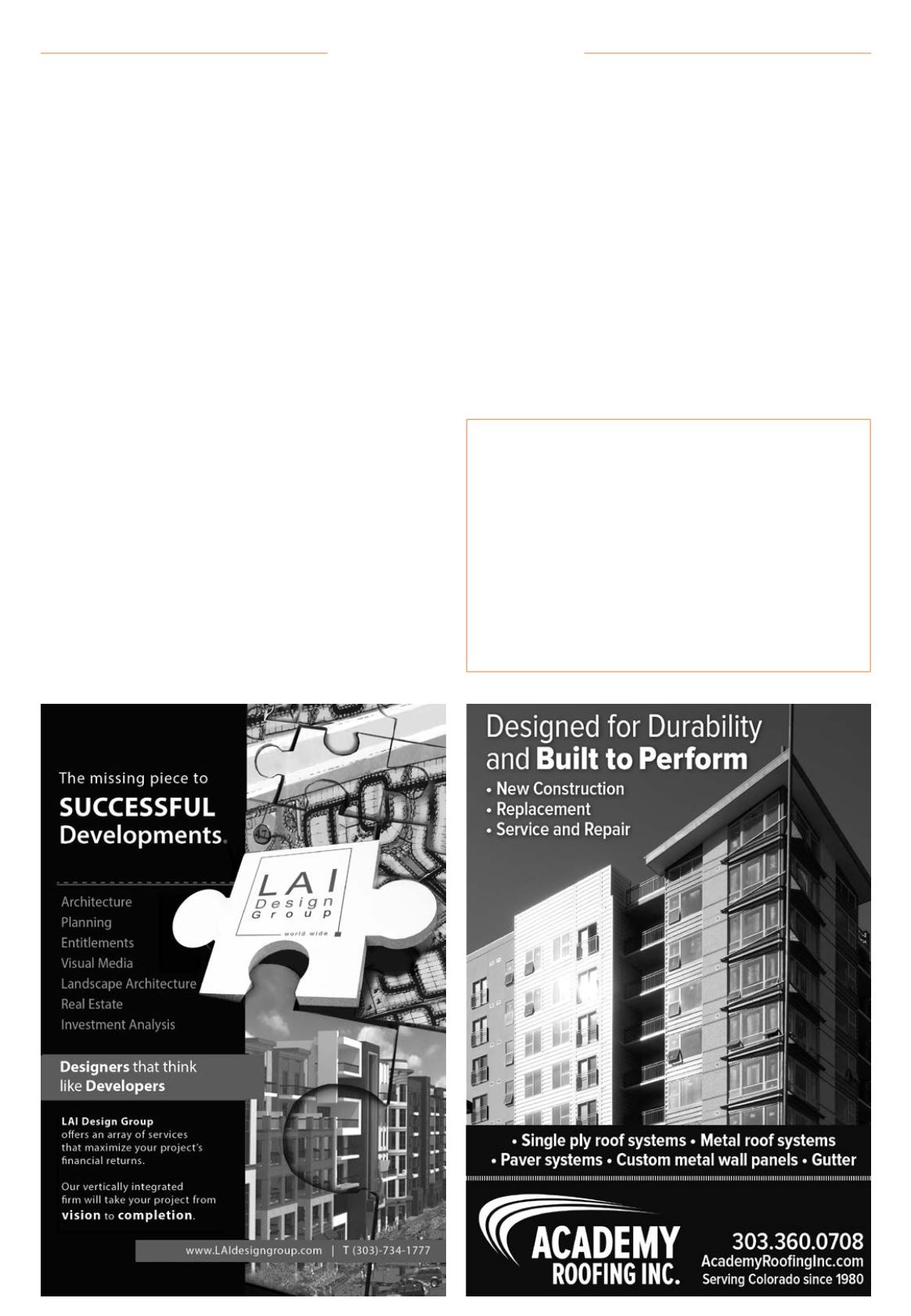

January 2015 — Multifamily Properties Quarterly —
Page 19
by Ryan Gager
A quick glance at any market
report will tell you all you need to
know about the Denver multifam-
ily industry this past year. Key
phrases such as construction boom,
strong sales activity, busiest year on
record, low vacancy, high absorp-
tion and rent growth littered the
pages of quarterly market reports.
The Downtown Denver Partnership
offered a simple statement that
could help explain this trend: “The
Economic Update paints a clear
picture: People want to be in Down-
town Denver.” The strong multifam-
ily market doesn’t start and end
with downtown either; the entire
metro area is experiencing high lev-
els of activity. Projections indicate
that the industry will continue to
stay hot through 2015.
“The multifamily industry is in
good shape right now,” said Jeff
Wikstrom, vice president of multi-
family development at Evergreen
Development. “There’s a demand
in the Denver metro area for apart-
ment units and when those units
are coming onto the market, they’re
being absorbed.”
The positive business climate
benefits everyone in the produc-
tion chain, from title, legal and
design consultants to contractors,
bankers, property managers and
brokers. Apartment communities
provide safe, comfortable housing
options to our growing work force,
create jobs in the construction and
management segments, and add
increased property and sales tax
revenue to our municipalities.
There are many factors contrib-
uting to the high absorption rates,
leading to the belief this current
cycle can be sustained for a longer
period of time.
"Many factors are helping the
apartment market right now, exem-
plified by the shrinking homeown-
ership rate, like high student debt,
flat incomes, a mobile workforce
and minimal condo development,"
said Cary Bruteig, principal of
Apartment Appraisers & Consul-
tants. “The state recently released
updated population projections,
which are higher than last year,”
he said. The Denver metro area has
been one of the fastest-growing
areas in the nation according to the
U.S. Census Bureau.
People having transient jobs, wait-
ing longer to start families, pay-
ing back student loans or simply
enjoying the appealing amenities
offered at apartments are other
reasons individuals are opting for
apartment life rather than buying
homes. How long this current cycle
of apartment growth can last is still
anyone’s guess.
At the moment, there’s nothing to
suggest that the multifamily mar-
ket won’t continue on its upward
trend into 2015 and beyond. Cur-
rently, almost 50 percent of build-
ing permits are allocated toward
apartment buildings. “This is double
the historical ratio of apartment
permits,” said Bruteig. While the
ratio of permits being allocated to
apartment buildings could decrease,
a reverse back to building more
single-family or detached homes is
unlikely, he said.
As many know, multifamily devel-
opment is cyclical. Having been
through ups and downs, Wikstrom
remains cautiously optimistic.
“Everyone is busy, stretched and
doesn’t have a lot of extra time
because business is so strong,” he
said. “Looking forward, we always
need to remember the past and pre-
pare for the times when the cycle
slows. The key to surviving the slow
times is what you do while things
are good.”
A look back to the down cycle
five or six years ago tells the story
– development slowed and com-
panies either went out of business
or downsized offices. “I think it is
really important to remember those
times, especially when we’re expe-
riencing what’s currently happen-
ing,” said Wikstrom.
Inexperience, greed and compla-
cency are all factors that can lead
to reckless behavior and are what
separate good business people from
savvy veterans who understand
what it takes to survive the real
estate roller coaster ride. Wikstrom
said that how you conduct yourself
and interact with others when busi-
ness is good sets you up to “be able
to keep the office open” when expe-
riencing a downturn.
Relationships are important in
any business, but especially in the
real estate industry where so many
people and companies have a hand
in making a development success-
ful. Now that you have your peace
of mind, let the good times roll.
s
Don’t let the good times get the best of youDeveloper Spotlight
Jeff Wikstrom is the vice presi-
dent of multifamily development
at Evergreen Development and
offers this advice when it comes
to conducting business:
Build relationships.
It’s under-
standable to get one project done
and move on to the next, but
find that little bit of extra time to
make connections with everyone
working on a project.
Don’t always charge top dollar.
It
may make the bottom line a little
bigger, but it’s probably not worth
the expense of having some-
one not want to work with you
because of cost.
Follow the golden rule.
Just
because you could get away with
something behind someone else’s
back, doesn’t mean you should.
Don’t burn bridges.
It’s more
expensive to get new customers
than it is to retain current ones.
“Not only are these good busi-
ness practices, but establishing
and nurturing your business rela-
tionships and friendships will lead
to something that you are able to
fall back on in times of need,” said
Wikstom.
Advice for Conducting Business















